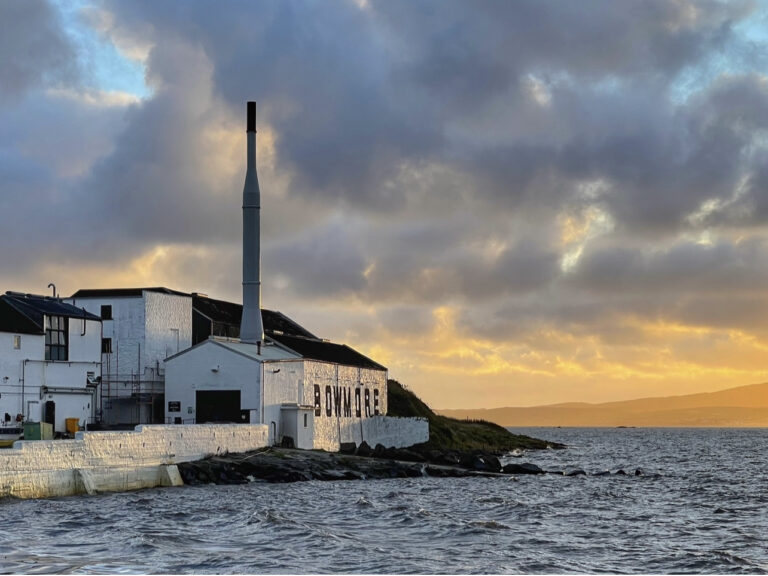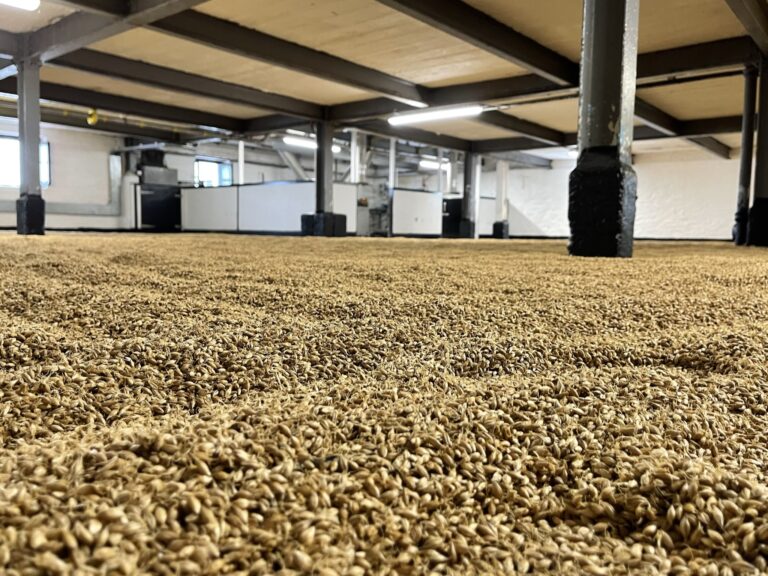Distillery Profiles:
Bowmore

Introduction
Bowmore Distillery stands on the shores of Loch Indaal, near the centre of Islay. It was established in 1779, making it the oldest distillery on the island. The name comes from the Gaelic, Bogh Mòr, meaning big bow, or big bend, in reference to the shape of the bay it overlooks. The distillery is owned and operated by Beam Suntory, a subsidiary of Suntory Holdings Ltd.
Character
Bowmore is a medium-peated spirit and less intensely smoky than some of its island neighbours. The traditional Islay peat reek is ever-present but feels more refined and dignified than the raw power of an Ardbeg or Laphroaig, When matured in bourbon casks, the whisky is salty and smoky with notes of tropical fruits. However, core range bottlings lean heavily towards sherry cask maturaton, which adds notes of chocolate and dried fruits to the experience.
Place and Production
Despite being founded almost 250 years ago, Bowmore continues to produce whisky using much the same process as when it started.
Bowmore is one of the few distilleries in Scotland to retain its malting floor. Around 20% of the distillery’s barley requirements are malted onsite with the rest supplied by Simpson’s of Dumfries & Galloway. All of the barley used in production is grown in Scotland and the malt is peated to around 25ppm (phenol parts per million).
The malting process at the distillery takes between 5 and 7 days depending on weather conditions. The barley is smoked in the distillery’s kiln for around 15 hours, then dried with hot air for a further 45 hours.
There are four pot stills: two wash stills and two spirit stills. The wash stills are capable of holding 30,000 litres each while the smaller spirit stills are charged with around 12,000 litres. The spirit run takes 3 hours with each run capturing around 4,800 litres of spirit.
The distillery holds around 23,000 casks on the island with the remainder of stock maturing on the mainland. A variety of casks are used to age the spirit including refill casks, bourbon barrels and ex-sherry casks. Most core range bottlings feature some combination of refill bourbon and sherry.
The distillery is renowned for its No.1 Vaults warehouse, part of which, lies below sea-level. One of the oldest of its kind in Scotland, the wall of the warehouse makes up part of the village’s sea wall and in the winter, the choppy waters of Loch Indaal crash against the stonework.
In the late ’80s, the distillery was fitted with an innovative heat recovery system that cut down on energy bills and recycled excess hot water. Morrison Bowmore, owners of the distillery at the time, donated an unused warehouse to the community and in 1991, it was converted into a swimming pool that could be heated by the distillery’s excess hot water.
History and Notable People
The Campbells and the Simpsons
The village of Bowmore was founded in 1768 by the Campbells. Several decades earlier, the family’s Glasgow property had been ransacked by protestors angry at Daniel Campbell MP’s support of the malt tax. The money paid to him by the government in compensation bought the island of Islay from another branch of the family. Perhaps still scarred by the events in Glasgow, the Campbell’s decided to rehome the population of Islay’s capital, Killarow, as they were too close to the family home at Islay House.
Bowmore was established as the island’s new capital and administrative centre on the banks of Loch Indaal. Within a decade, there was a distillery operating at the heart of the village. It was established by David Simpson of Bridgend and while official records show the distillery’s beginnings in 1779, there are claims that it was operational for some time prior.
By the 1840s, Bowmore had outgrown its meagre water source. In a considerable feat of engineering, a seven mile-long lade was constructed to bring water from the River Laggan. The distillery continues to use it to this day.
Stanley P Morrison
Stanley Morrison’s career began in 1925 when he took a job at his father-in-law’s whisky brokerage. Seven years later he went into partnership with Robert Lundie before striking out on his own in 1935.
Morrison’s success as a broker saw him enter the world of distilling when he purchased Bowmore in 1963. The spirit produced during his time at Bowmore, particularly in the 1960s, has achieved legendary status. The famous Black Bowmore single malts were distilled during this time, for example.
Under the name of Morrison Bowmore Ltd, the company expanded with the acquisition of Glen Garioch and Auchentoshan. In the 1980s, perhaps attracted by this growth, Japanese distilling giant, Suntory, invested in a 35% stake in the business before buying it outright in 1991.
The Morrison family continue their involvement in the Scotch whisky industry through the likes of A.D. Rattray, The Clydeside Distillery, Càrn Mòr and Aberargie Distillery but for Bowmore, the sale marked the start of a new chapter.
The Suntory Era
Suntory Holdings is a Japanese multinational brewing and distilling company with a history that dates back to 1899. As the employer of the famous Masataka Taketsuru, it was responsible for kickstarting the Japanese whisky industry.
At the time of Suntory’s takeover of Bowmore, Jim McEwan was serving as distillery manager. In his book, A Journeyman’s Journey, he tells of the day he took a phone call from the owners, asking where they could land four helicopters.
Jim managed to arrange the use of the school playing field and there, in front of the watching school children, the helicopters arrived. The first carried Tim and Brian Morrison (sons of Stanley) and Jim Howatt, chairman of Morrison Bowmore. In the second was Mr & Mrs Shin Torii of Suntory, who had flown all the way from Tokyo with a view to buying the distillery that very day. In the third and fourth helicopters were several lawyers ready to make it all happen.
The deal was done and Suntory remain at the helm of Islay’s oldest distillery today, more than three decades later. The parent company’s 2015 takeover of Jim Beam created the subsidiary, Beam Suntory, and brought Bowmore under the same umbrella as Laphroaig for the first time.

Curious Tales
This is another Jim McEwan story that offers a glimpse of the old days, when distilleries were at the heart of their local communities.
In years gone by, distilleries were viewed by some of the men that worked there as an extension of their own sitting room. During the night shift, people would often drop in to see them. Sometimes, a crowd would gather and a spontaneous ceilidh would ensue with drinks and laughter. Some of the men would even play the odd tune on the pipes.
One of the men had a wee, three-legged dog and one evening, during a gathering in the still-house, one of the pipers scooped up the wee dog, petted it, tucked it under his arm, stuck the tip of its tail in his mouth and proceeded to ‘pipe’ a tune on its three legs.
The wee dog, indignant at the situation it found itself in started to yowl and howl in tremendous fashion. Quick as a flash, the stillman spoke up “that’s the best tune you’ve played all night!”



